Non-Surgical Bunion Treatment
We offer an innovative non-surgical bunion and hammertoe treatment solution utilizing extracorporeal shockwave therapy technology. Shockwaves are powerful acoustic waves used widely by medicine to break apart kidney stones.
We have developed a protocol to remove bunions and hammer toes by targeting their characteristic calcium deposits and joint capsule swelling using shockwave therapy, combining the capabilities offered by both radial and focused versions of the technology.
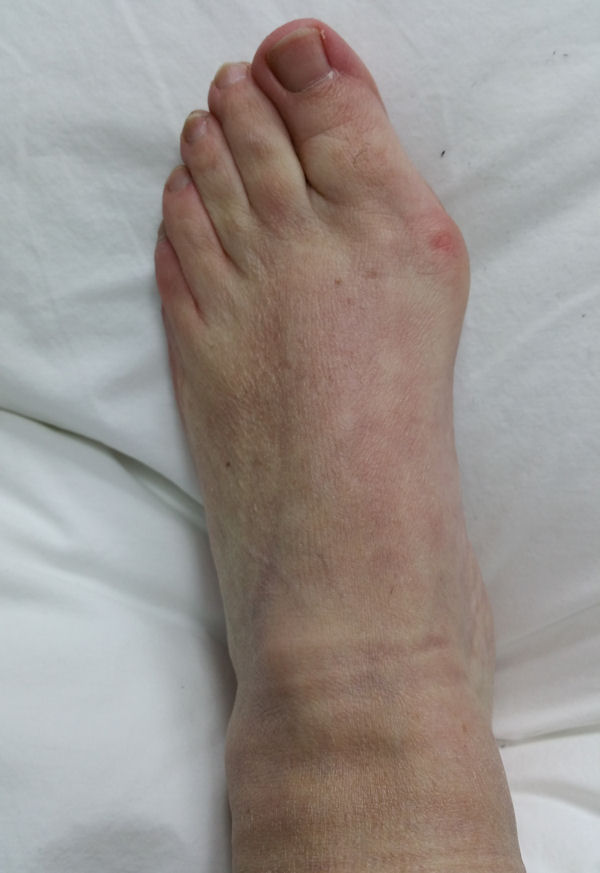
◄ The illustration on the left shows the bunion before the treatment
► The illustration on the right shows Glenn pinching the loose skin to show how much the bunion shrunk after 1 treatment
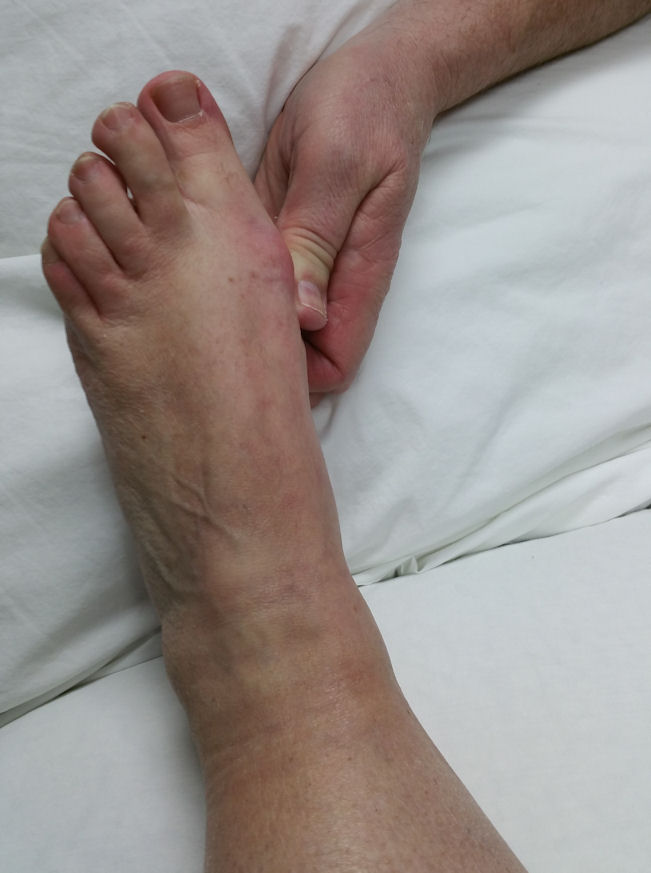
Bunions and hammertoes vary in composition, with some comprised entirely of calcium like a kidney stone, others entirely of hardened joint capsule swelling, yet others are comprised of a combination of both.
Our non-surgical bunion treatment and removal process really works, but not for everyone. There are 3 factors which dictate whether our treatments will be successful.
Bunions comprised of calcium only can be successfully removed. Calcium deposits are the body’s reaction to prolonged pressures on the joints structures, caused by some mechanical fault with the skeleton. We identify the fault correct it, and remove the calcium.
Joint capsule swelling common to some bunions develops for 2 reasons. Prolonged pressure on the joint as mentioned above can also result in strain on the ligaments which hold the bones of the joint together. Just like with the calcium deposits, swelling caused by ligament strain can also be removed and won’t return either, because the same mechanical fault(s) identified with the pelvis or foot is corrected.
The second type of swelling that can accompany some bunions results from joint cartilage degeneration. The cartilage is the smooth lubricated tissue that lines the joint surfaces of both bones in the toe joint. It allows the joint to move through its full range of motion with a smooth gliding action. If the cartilage on one or both bones becomes thin or pitted losing some or all of its lubrication, low-level grinding develops resulting in the production of swelling. This swelling remains in the joint capsule causing it to expand, similar to filling a balloon with water. The connective tissue surrounding the joint bulges outward. When you see this bulging and feel it, you would swear that it is calcium or bone, but it is not. The connective tissue and joint capsule are enormously strong and durable not allowing the swelling to easily drain out. We can flush this swelling out of the bunion but it won’t stay out. Since there is joint cartilage degeneration, the swelling will always be produced whenever the toe is bent during walking, and our treatments can’t possibly change this situation. This cartilage degeneration is the one variable that determines whether we can totally remove a bunion.
Conclusion:
We can successfully remove a bunion non-surgically if it is comprised of calcium, ligament strain swelling or both. We can’t remove any bunion which has swelling due to joint cartilage degeneration. However, our treatments have the ability to shrink it in size for some, depending on the degree of degeneration in the cartilage.
We can’t guarantee the removal of all bunions but can guarantee:
* Treatments will eliminate pain in any bunion no matter what it is comprised of.
* Most hammertoes are comprised of calcium and ligament swelling but not cartilage degeneration.
Be proactive when it comes to your health. Don’t let things go.
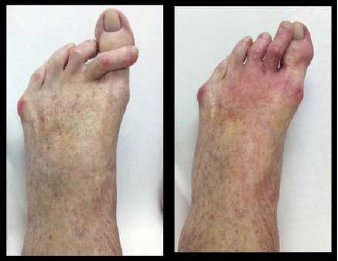
A remarkable outcome but unfortunately this treatment did not last.
This person suffers permanent damage by not seeking help earlier.
Before Non-Surgical Bunion Treatment Begins
Treatments do not harm the toe in any manner. Shockwaves are powerful acoustic (sound waves), applied to the skin over the bunion passing through a gel we apply during treatment. They produce an internal pressure within the calcium deposits breaking them apart into a fine powder consistency. They also produce a pressure sufficient to flush out trapped swelling from the joint capsule resulting from prolonged forces exerted on the joint.
Multiple treatments are required to shrink a bunion or hammertoe. The composition of each bunion or hammertoe dictates how many treatments will be required to remove it, not its size. Typically most bunions require 3-10 treatments.
We can provide non-surgical bunion treatment to most people no matter how old they are. The only restrictions we have in treating anyone is that they must be reasonably healthy overall, have good circulation into their feet and have no degenerating effects of diabetes.
Treatment Begins
Bunion Treatments involve the precise application of shockwaves directly on the skin over the variably shaped surfaces of the bunion. These shockwaves produce small pockets of internal pressure into the bunion which begin breaking apart that region. As the minutes’ pass, the shockwave applicator is directed in an ever-changing pattern to address the key regions of the bunion which must be dealt with before other regions are targeted. This treatment pattern is determined by the type of bunion, how much swelling is present, where the calcifications are and so on.
The first few minutes feel a stinging sensation as the shockwaves begin propagating inward. Quickly these sensations subside and sensations of pressure are noted. Shockwave Pressure sensations mean treatments are now doing their work, breaking apart calcium and flushing out swelling. You see the effects of this as it happens which most people find fascinating. Bunion treatments address the desires of the individual receiving treatment. If a high point in a bunion rubs inside a shoe, then it is removed first (see image to the right). If the joint motion is restricted (hallux rigidus/limitus) or is not moving at all (arthritis), then these issues are targeted first. Pain in a bunion if present, is eliminated during treatments. Any sensations experienced during treatment diminish as the minutes pass.
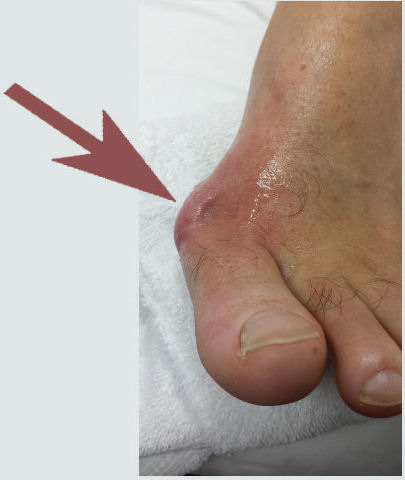
We often put holes in bunions to reduce high points,
and to weaken the region to prepare for another angle
of attack.
For many years I had difficulty buying shoes that would not cause pain to my bunion. Not wanting to go through surgery, I decided that I would try shockwave therapy as an alternative treatment. I had heard some really good comments about Glenn’s facility so I decided to give it a try. From the very beginning, I was really impressed. Glenn is very knowledgeable, experienced, confident and he is able to treat and advise on a wide range of health issue. What I really appreciated was his honesty. From the very beginning, he told me that the therapy would help but would not eradicate my bunion completely. I had another foot problem that I was not aware of but it was all related to the bunion, and that problem was solved after a few treatments. I still have a bump but it is much better than what it used to be. I will continue to refer family and friends to this excellent facility. Thank you, G, Glenn, for your help!!!
After Treatments
Once a treatment has been completed, the toe will be red and in some cases swollen. This is due to the irritation the shockwaves caused to the skin and connective tissues in the region. This is a normal occurrence and an essential part of the process. The ensuing swelling is the body’s mechanism to remove debris including calcium particles, metabolic waste products which were trapped in the connective tissues and unwanted collagen connective tissue fibres from the region.
All debris is cleared from the region by the lymphatic system and brought up to the lymph nodes in the groin. The nodes chemically degrade all debris back to their chemical molecular components then recycle it. Calcium is returned to the bones where it belongs, proteins are recycled and all remaining metabolic waste products are excreted from the body during urination.
The lymphatic system does this on a constant basis normally, so treatments give it a little more work to do for those brief minutes after treatments. This is why we can’t treat anyone who suffers from decreased circulation into their legs.
Note
The calcification component of bunions is not related in any way to the consumption of calcium supplements for bone health. Calcium deposition within some bunions is a normal process for some whether they take calcium supplements or not. Don’t ever stop taking dietary calcium.
In almost all cases, those treated notice more flexibility and motion in the toes noticed when walking out of the treatment room. Those who suffer from hallux rigidus/limitus see a profound and immediate change in the way they walk since the range of motion in the toe is better than it has been for some time.
There are times when our treatments remove an enormous amount of swelling and calcium which leaves the skin loose where the bunion once was (see image above). This loose skin will shrink over the weeks to come unless the bunions were so large and the skin stretched so much, that it won’t fully recover.
Bunion treatments do not have to be administered on any timeline. Some come in weekly while others monthly. Since the mechanisms responsible for bunion formation have been addressed, treatments can be administered whenever desired.
The cost of treating bunions varies, based on the number of shockwaves administered during each treatment, and the type of shockwave unit being utilized. Some bunions require focused shockwaves therapy, while others are best treated with more expensive, more powerful radial shockwave therapy. The degree of calcification, its density, and location to the joint cartilage, all factors in our dynamic treatment decisions. Treatments do not exceed $300.00 for a 2 bunion treatment.
Total recovery from bunion treatments is usually 24 hours or less for most. Those with severe joint arthritis feel discomfort in the joint for up to 3 days before it diminishes. These treatments do not cause any long-term issues of any nature.
Local clients to our clinic, considered to be within 6 hours drive away, can be treated and return home the same day. However, we can administer 2 treatments within a short time frame, one each day for 2 days if desired. So those who are within 6-12 hours drive from the clinic may choose to stay over 1 night, to receive treatment the day they arrive, and the second the following morning before returning home.
Note
We cannot eliminate any bunion in one round of treatments to our clinic no matter how long you stay. The body requires time to clear the debris and restore normal circulation to the region. New blood vessels begin growing into regions which have experienced connective tissue damage due to prolonged forces on its fibres. Strained ligaments begin to heal as the forces are removed from their fibres. The joint cartilage begins to calm down as the forces are removed from its surfaces. Ideally, we offer treatments once per week, or every second week, depending on the person and the characteristics of their bunion(s).
If you’re considering traveling a distance to work with Glenn at his therapy clinic, I can assure you that it is well worth the trip. This man really knows his stuff. I would be happy to talk with anyone about my experience.
NON-SURGICAL BUNION TREATMENT – OVERVIEW
Composition: What Comprises A Bunion?
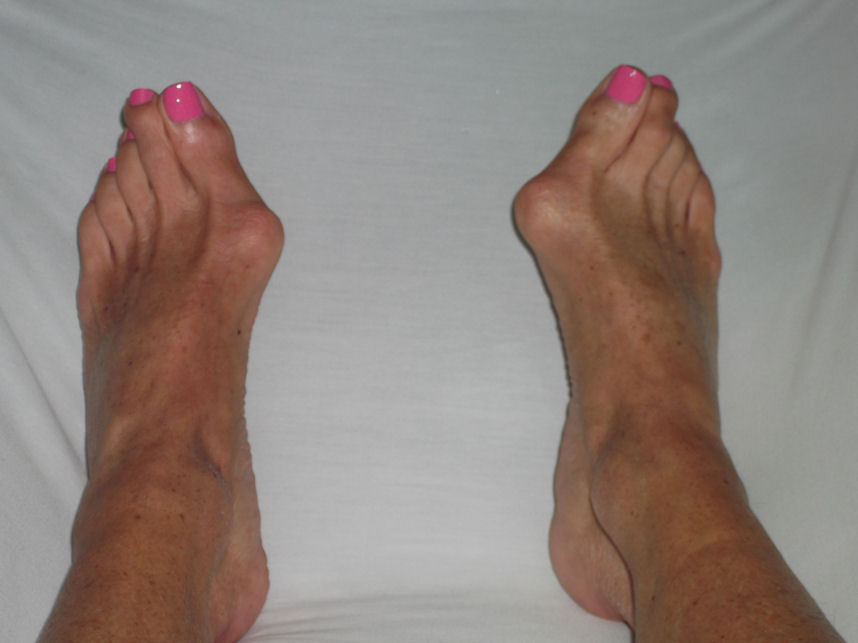
End of the toe bone protruding outward as the lower end deviates inward (Hallux Valgus)
Hardened connective tissue
Hardened connective tissue with calcium deposits
Calcium deposits alone
Swollen joint capsule – Inflammation
Bunions can form anytime in one’s life, no matter the age or sex. Two conditions must be present in order for a bunion to form.
1: You must have one or more of the identified factors, as listed below, and have had them for a sufficient amount of time determined by your body.
*Wearing shoes that are too tight, or too small.
*Wearing shoes that are too loose – not laced up.
*Wearing shoes that are elevated at the heel.
*Incorrect shape of the bones in the foot.
*Improper movement (interplay) of the bones in the foot.
*Flat feet! – Short leg! – Loose ankle ligaments (pronation).
*Muscular imbalance or joint dysfunction in the pelvic region.
*Trauma to the foot leg or pelvis perhaps with pins, plates and/or screws.
*Trauma or malformation to the opposite foot.
*Nerve compression anywhere from the pelvis down into the foot itself.
2: Your body must have the type of aggressive response mechanism, required to attack the affected toe in an effort to resolve the issues (identified factors).
Identified Factors To Bunion Formation:
The above mentioned identifying factors are all capable of causing a bunion to form in anyone. Many people do have these factors and yet do not have a bunion. That is because they do not have the second of the 2 above mentioned physiological conditions required for a bunion to form, being the aggressive reaction mechanism. If they never develop this aggressive response mechanism a bunion will never develop, even if they have one or more of the above-mentioned factors.
Bunion Formation: What Actually Happens?
The human body is an amazing machine that medicine is still trying to totally figure out. One of its most amazing aspects is the ability to change or adapt to stresses that are placed upon it to cope with that stress. Consider how the bones of the body will thicken in response to stress on them, as is the case with regular exercise. Muscles will also become thicker and stronger in response to stresses placed upon them. The key point to understand here is that the body will either make a body part stronger or thicker until this reinforcement equals the forces that have been exerted on it. This is what is termed “equilibrium”.
“Bunions can begin to form in men and women of all ages, from their early teen’s right up into their 80’s.”
Bunions form as a result of excessive prolonged forces on the big toe, due to the presence of one or more identified factors as seen earlier. Usually, these forces are against the side of the toe, pushing it towards the toe beside it. Remember the term equilibrium. With prolonged excessive forces on the big toe, there is no longer equilibrium with the joint, but rather an imbalance caused by an increased amount of pressure on the side of it. After a certain amount of time, variable from person to person, the body will begin its attempt to regain equilibrium. There are always exceptions to every rule. For reasons unknown, some people’s bodies will not try to establish equilibrium, when prolonged excessive forces are present on their feet. For these lucky people, for that moment in time, they will not develop a bunion. For all the rest of us, the process to regain equilibrium will ensue.
When your body has decided it has had enough with that constant pressure on the big toe, an aggressive attempt to regain equilibrium begins. For reasons unknown, your body will choose various materials to reinforce the joint. As mentioned at the beginning of this text, those materials include calcium, connective tissue and/or additional fluid.
In some rare cases, there is no aggressive bunion building mechanism implemented by the body. Instead, the joint simply becomes swollen and inflamed complete with pain, and no build-up of calcium or connective tissue. The additional build-up of fluid in the region will cause the joint capsule to swell, increasing pressure on the sensitive pain receptors in the region. The presence of pain along with the swelling will decrease the joints ability to move, restricting it. A bulge may develop on the side of the toe appearing as if it is a full blown bunion.
As time passes, if what the body has done already does not regain equilibrium between the excessive forces on the toe and the reinforcement mechanism, then the body will continue its build-up. Again for reasons unknown the body may switch its choice of reinforcement material, going from pain and swelling to calcium deposits or from calcium to connective tissue or vice versa. Most bunions we treat are comprised of a combination of calcium and connective tissue.
In the early stages of bunion formation, the body will begin sending in to send in strong collagen fibres which may be deposited directly into the joint space. This provides additional force on the outside of the joint in an attempt to equal any side forces in the opposite direction, being toward the second toe. With this joint involvement, pain may become noticeable along with some redness, due to the invasion of extra tissue placing pressure on the joint cartilage. This build-up of collagen fibres, along with a tightening of the existing connective tissue in the region will cause the famous lump on the side of the toe. If the toe bone begins to deviate towards the second toe, then the lump will appear larger due to the upper end of it protruding outward against already swollen tissues. This process will continue until equilibrium is reached.
Bunion Variations: 5 types of bunions
Type 1: Inflammatory Bunion
This type of bunion occurs gradually, increasing in size and pain over weeks or months. the entire bunion may go between periods of extreme pain and swelling, to almost be gone only to return once again. Eventually, it flares up again and remains until something is done to correct the forces on the foot responsible for its formation.
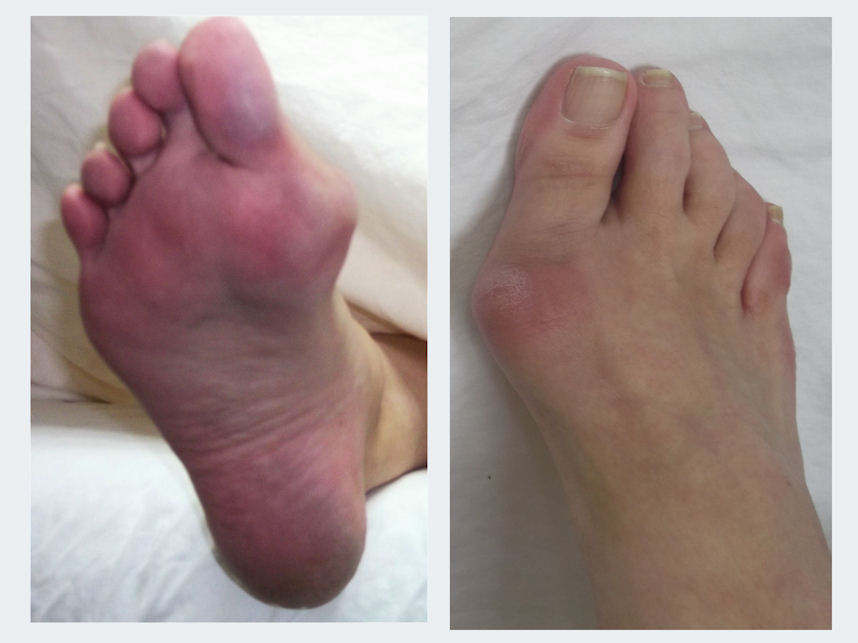
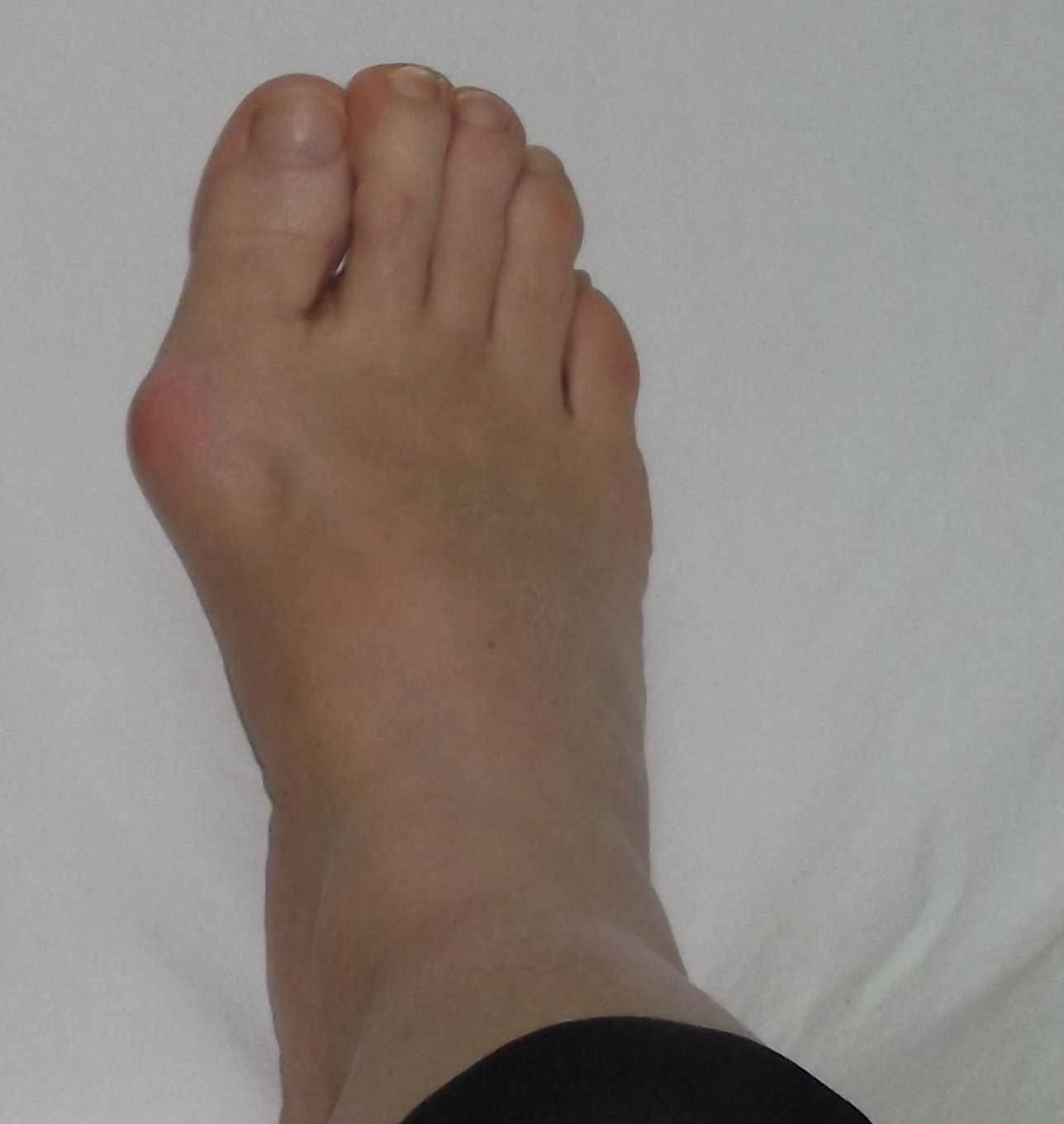
We have seen calcium deposits go right up to the side of the long toe bone (metatarsal) to the bridge of the foot. Extremely large common bunions take longer to fully remove due to the extremely large surface area they cover.
Treating this type of bunion is amazing to most due to the rapid reduction in size in the first few treatments. Since the outer layers of calcium are composed of a softer calcium, it is very easy to remove. Most people who have had their bunion rub inside their shoes will see an immediate looseness in their shoe immediately after their first or second treatment.
Most bunions on the right foot are of this type!
Treatment of compilation bunions can be extremely fast, if small enough, or can be slow if they are significantly high and comprised of a harder form of calcium. Note! Toe spacers should never be used to help straighten a crooked toe! The toe is crooked due to the presence of calcium within the joint space. Trying to force a toe to straighten while calcium is wedged in the joint will result in joint damage!
Type 3: Compilation Bunion
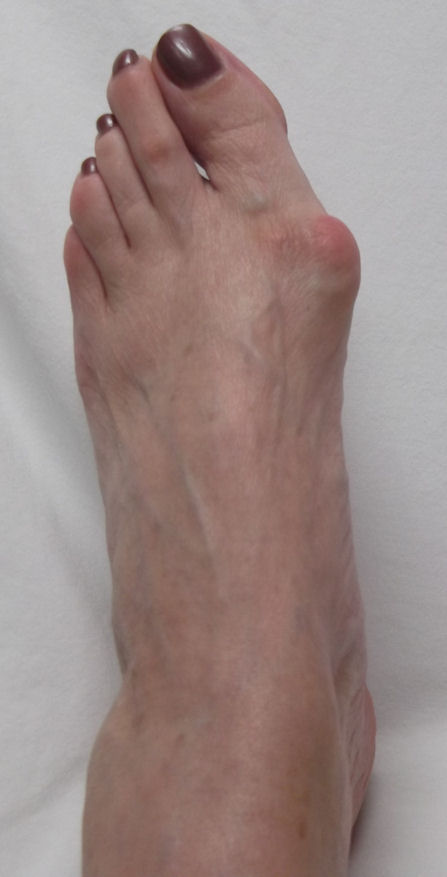
Type 4: Calcium Bridge Bunion:
In this rarest of all types of bunions, Calcium deposits begin to accumulate along the lines of force at the big toe joint resulting from an unresolved mechanical skeletal fault. A calcium bridge begins to form at the joint line of the big toe. Just like the construction of a road bridge, an Abutment of calcium begins to develop on both sides of the joint line, followed by a very strong connective tissue bridge linking the two mounds of calcium together. As more time passes, this connective tissue bridge will eventually become calcified and complete the calcium bridge. At this point, your toe will no longer move up and down at the joint. Multiple bridges can exist in a given toe ensuring a very solid reinforcement process is in place. We have seen as many as 4 calcium bridges crossing a big toe joint. With this particular reinforcement mechanism, the body seems to have decided that no lesser reinforcement type would be sufficient, and it went right to the most aggressive form in an attempt to reach equilibrium. The amazing aspect of this is that a completed calcium bridge does actually cause equilibrium, as no outside forces will ever again act on a bridged toe joint. They would have no effect in moving it in any direction. The toe joint has been fused!
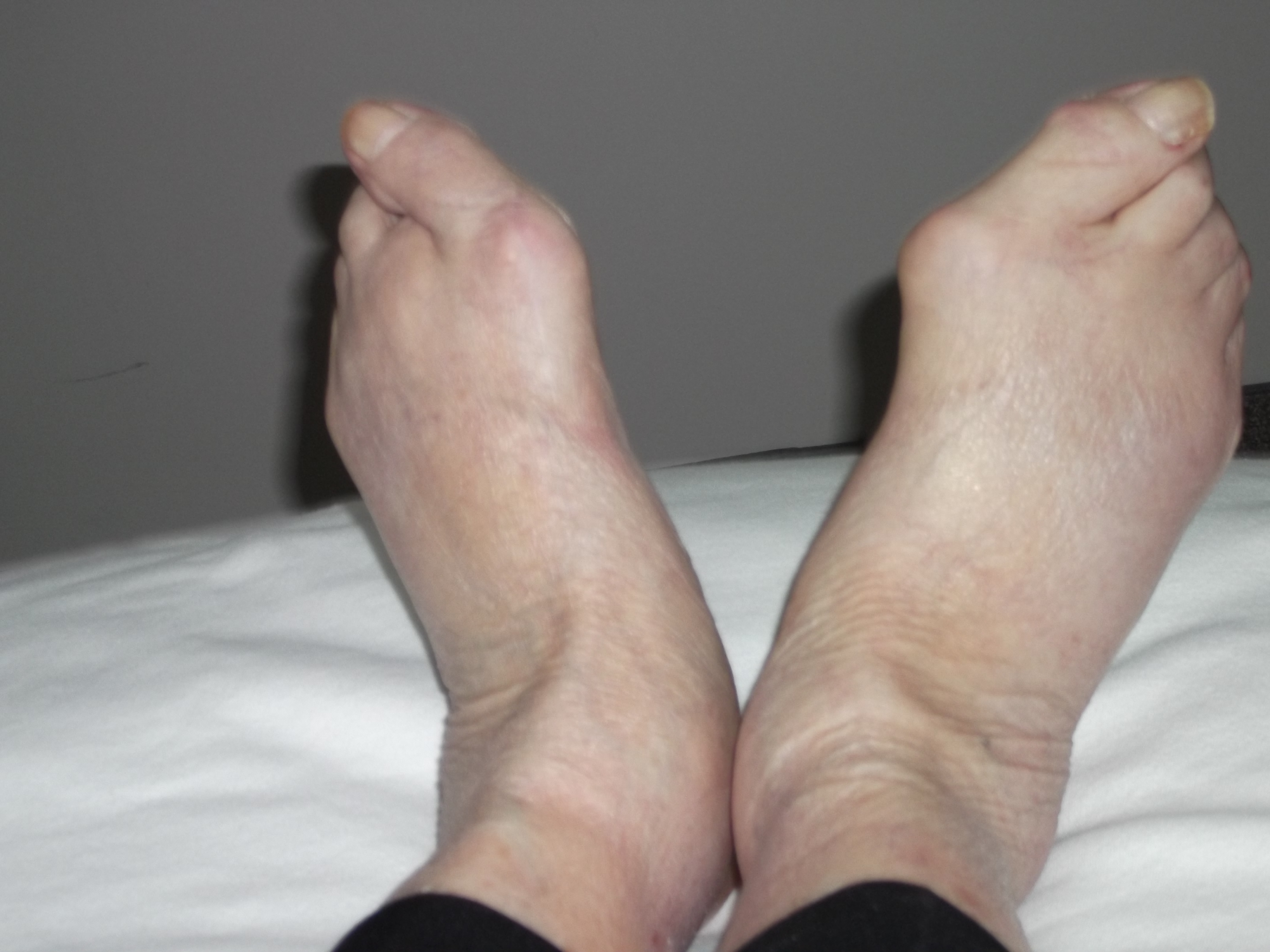
First, the calcium in this type of bunion is the of the hardest, most dense form seen in any bunion with a potential bony matrix interspersed throughout its mass. It is as close to real bone as it could ever come.
Secondly, These bunions at times can’t even be seen as their calcium is of a low-profile appearance with a small knob on the upper/outer side of the toe. the deposition of calcium does not follow the normal pattern seen in the other four bunions. The deposited calcium is laid down along the entire joint line of the toe, and a small lumpy deposit on the upper outer aspect of the toe.

